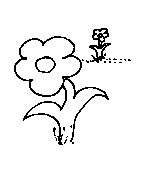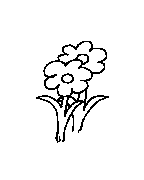Placement
Without getting too deep into the concept of the horizon,
it should be noted that objects higher in a picture tend to
look farther away. Without the use of some other trick, this
technique will not create great depth, but it can help to
distinguish spatial relationships to some small degree. This
trick works best when the picture is meant to be seen below
eye level. For pictures of sky, higher objects often appear
closer. For space pictures, the farther objects might be
situated closer to the center. This Trick does work, but
usually in conjunction with some other trick.
|

|
Size
Shapes that should be about the same size if they were
real, will appear smaller as the become farther away. This
is the classic law of diminution. It works best when whoever
views the picture has an expectation of relative sizes, like
when a bunch of people should be about the same height. Any
change in that expectation causes a shift of perceived
perspective.
|

|
Overlapping
When one image obscures another, there is little doubt
which is meant to be in front, and which behind. This can be
as simple a process as erasing the parts that should not
show. When one shape effectively cancels what we see of
another, the interposed one always seems to be in front.
|

|
Density
The closer something is to us, the more detail we can
perceive. By selectively eliminating detail, we can force
objects to seem to disappear in ah haze. The next time you
are walking or driving in fog, notice how things fade more
quickly, and the feeling of perspective becomes enhanced.
This principle is less noticeable, but also present without
fog, and occurs naturally over great distances where the
landscape fades in the distance.
|

|
Surface
The careful application of surface line and perceived
texture can add depth and a feeling of weight to a picture.
When lines curve around the surface of a shape, they can
create the impression of areas that curve in and out. The
depth created may initially seem negligible, but when built
up throughout a picture, surface line can create the feeling
of great depth with intense precision.
|

|
Shading
Simply by adding proper shadows, a flat image seems to
acquire mass. When shadows are cast on and by objects, a
strong feeling of spatial relationships is created. Without
mass and perspective, shadows are meaningless. The Converse
is also true. Meaningful shadows create an illusion of mass
and perspective.
|

|
Foreshortening
This is a catch all concept that illustrates the fact
that as an object is turned away from the viewer, the
overall shape seems to distort. Closer surfaces may take on
emphasis in size and detail, while parts turned away will
become smaller and even disappear from sight. Circles become
ovals and ellipses, and squares become rectangles, while
previously unseen surfaces may become prominent.
|

|
Color
Adding color to an image can make a great difference in
how it is perceived. Darker or "cooler" colors like violets
and blues often tend to seem to recede, while "warmer"
colors like red and yellow will tend to pop forward. Colors
that are hazy in appearance may bring the trick of density
into play as well.
|

|








